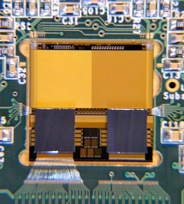LCFI


LCFI - The Linear Collider Flavour Identifier
Edinburgh is part of the LCFI collaboration. LCFI is investigating advanced silicon detector technologies to test their suitability for building the part of a vital part of the ILC detector, called the vertex detector. Our current efforts are focused on two technologies: column parallel CCDs (CPCCD) and In-Situ Storage devices (ISIS). You can learn more about these below.
An illustration of one design for the ILC vertex detector is shown above left. Inside the vertex detector are layers of very precise silicon sensors. The silicon detectors record the position of charged particles which created in the collisions at the ILC. Using this accurate position information we hope be to able to identify which type particle it was. In particular the information from vertex detector helps distinguish between the different kinds, or flavours, of quarks - bottom, charm and the lighter quarks (up, down and strange).
Read more about LCFI at the LCFI home page.
CPCCD Senors
CCDs are the sensors that are commonly used in digital cameras. CCDs are sensitive to photons (particles of light) and also to charged particles - such as those created in particle physics collisions. CCDs are basically a grid of tiny capacitors, known as pixels. Our design is for pixels 20 micrometres times 20 micrometers (0.002 cm x 0.002 cm). To read out the photograph, or the particle collision, the information from each pixel is shunted to the bottom of the grid and then along the bottom to the read out electronics. However, standard CCDs are far too slow for our purposes as we need to read them out them out every 50 microseconds! Column parallel CCDs readout each column separately: speeding up the readout speed by a factor of around 10,000! Quick enough for our needs.
ISIS Sensors
Although the CPCCDs are a very promising technology for the ILC, they have some shortcomings. We don’t want too many of the pixels to have information in them. We’d like to keep the number with information in them to less than 1 in 1,000, so we can easily match it up with the information from the other detectors. To see why, it’s useful to understand a bit about what goes in the ILC collider itself. We collide two different kind of particles - called electrons and positrons. We collide ‘bunches’ of electrons and positrons each containing about 100,000 million particles each time. Now the important part. The collisions take place 2820 times in about 1 millisecond (0.001 seconds) and then there are no collisions at all for almost 0.2 seconds. You can see an illustration of this below.

Basically there’s a lot going on for 1 millisecond - and then nothing for almost 0.2 seconds.
Using CCDs, in order to keep the number of pixels with information to less than 1 in 1,000, we have to collect the information from the pixels 20 times during the 0.1 milliseconds of collisions. However, it would be if we could read it out, at a leisurely pace, in the 0.2 seconds of quiet time when there’s no collisions. This is the idea with the ISIS senors, shown below. 20 times during the collision time we store the data in a buffer within the pixel itself (represented by the little black ovals). We then read out all the information in the buffers of all the pixels during the quiet time between collisions.

You can see some pictures of the LCFI testbeam experiment to test the ISIS sensors response to a high-energy electron beam here.




